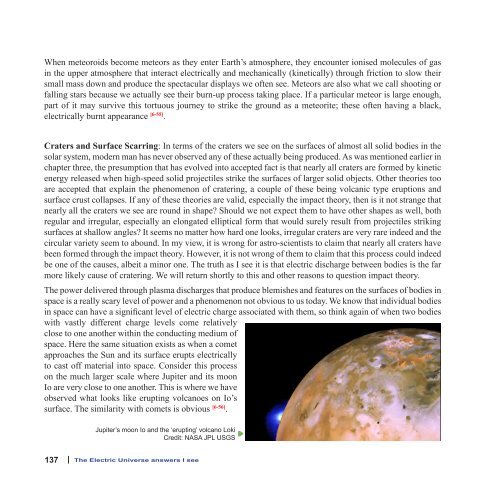A Beginner's View of Our Electric Universe - New
A Beginner's View of Our Electric Universe - New
A Beginner's View of Our Electric Universe - New
You also want an ePaper? Increase the reach of your titles
YUMPU automatically turns print PDFs into web optimized ePapers that Google loves.
When meteoroids become meteors as they enter Earth’s atmosphere, they encounter ionised molecules <strong>of</strong> gas<br />
in the upper atmosphere that interact electrically and mechanically (kinetically) through friction to slow their<br />
small mass down and produce the spectacular displays we <strong>of</strong>ten see. Meteors are also what we call shooting or<br />
falling stars because we actually see their burn-up process taking place. If a particular meteor is large enough,<br />
part <strong>of</strong> it may survive this tortuous journey to strike the ground as a meteorite; these <strong>of</strong>ten having a black,<br />
electrically burnt appearance [6-55] .<br />
Craters and Surface Scarring: In terms <strong>of</strong> the craters we see on the surfaces <strong>of</strong> almost all solid bodies in the<br />
solar system, modern man has never observed any <strong>of</strong> these actually being produced. As was mentioned earlier in<br />
chapter three, the presumption that has evolved into accepted fact is that nearly all craters are formed by kinetic<br />
energy released when high-speed solid projectiles strike the surfaces <strong>of</strong> larger solid objects. Other theories too<br />
are accepted that explain the phenomenon <strong>of</strong> cratering, a couple <strong>of</strong> these being volcanic type eruptions and<br />
surface crust collapses. If any <strong>of</strong> these theories are valid, especially the impact theory, then is it not strange that<br />
nearly all the craters we see are round in shape? Should we not expect them to have other shapes as well, both<br />
regular and irregular, especially an elongated elliptical form that would surely result from projectiles striking<br />
surfaces at shallow angles? It seems no matter how hard one looks, irregular craters are very rare indeed and the<br />
circular variety seem to abound. In my view, it is wrong for astro-scientists to claim that nearly all craters have<br />
been formed through the impact theory. However, it is not wrong <strong>of</strong> them to claim that this process could indeed<br />
be one <strong>of</strong> the causes, albeit a minor one. The truth as I see it is that electric discharge between bodies is the far<br />
more likely cause <strong>of</strong> cratering. We will return shortly to this and other reasons to question impact theory.<br />
The power delivered through plasma discharges that produce blemishes and features on the surfaces <strong>of</strong> bodies in<br />
space is a really scary level <strong>of</strong> power and a phenomenon not obvious to us today. We know that individual bodies<br />
in space can have a significant level <strong>of</strong> electric charge associated with them, so think again <strong>of</strong> when two bodies<br />
with vastly different charge levels come relatively<br />
close to one another within the conducting medium <strong>of</strong><br />
space. Here the same situation exists as when a comet<br />
approaches the Sun and its surface erupts electrically<br />
to cast <strong>of</strong>f material into space. Consider this process<br />
on the much larger scale where Jupiter and its moon<br />
Io are very close to one another. This is where we have<br />
observed what looks like erupting volcanoes on Io’s<br />
surface. The similarity with comets is obvious [6-56] .<br />
Jupiter’s moon Io and the ‘erupting’ volcano Loki<br />
Credit: NASA JPL USGS<br />
137 | The <strong>Electric</strong> <strong>Universe</strong> answers I see


